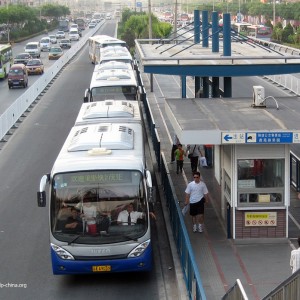
Beijing’s Rapid Bus Transit (BRT) opened on December 30, 2005 and quickly began to transform transportation in the crowded city.
The 16-kilometer, 17-stop route, dubbed “Southern Axis BRT Line One,” links eight residential areas, with a total population of 200,000, and four bustling commercial circles in the city’s southern districts. In its two months in service it has attracted overwhelming ridership, with daily passenger flows averaging around 80,000 commuters. Officials originally expected the peak flow—estimated at around 150,000 passengers per day—to occur in 2007, but on the third day of operation, ridership already neared 130,000.
As Beijing continues its rapid expansion, residents of the city’s older core districts will increasingly be pushed out into the suburbs, making it nearly impossible for them to bike or walk to workplaces and other destinations in the city center. Most of these people end up being dependent on public transportation. Yet over the past decade, the lion’s share of Beijing’s transportation dollars has gone to expanding roads, crossroads, and parking lots, which mainly benefit car users.
An influx of cars inevitably slows down traffic, while inadequate investment in public transportation leads to decaying services and a shrinking customer base. In Beijing and throughout China’s cities, many former bus riders have been forced to resort to cars to avoid increasingly long bus rides and exhausting walks to local stops—only adding to the worsening road congestion.